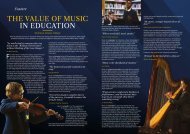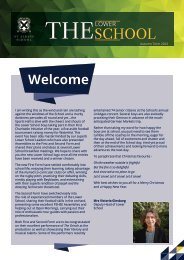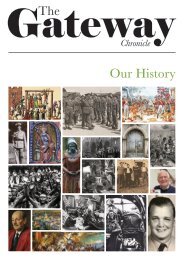You also want an ePaper? Increase the reach of your titles
YUMPU automatically turns print PDFs into web optimized ePapers that Google loves.
52<br />
Clergy, which redrew regional clerical<br />
boundaries (the dioceses) to match those<br />
of the state. <strong>The</strong> Assembly eventually pronounced<br />
that all members of the Clergy<br />
must have sworn allegiance to the new<br />
Constitution or risk losing their job. This<br />
was condemned by Pope Pius VI, leading<br />
to a two-way split in the<br />
French Clergy. <strong>The</strong> socalled<br />
refractory priests<br />
were those who refused<br />
to take the oath and<br />
sided with the Pope,<br />
whilst over half of parish<br />
clergy did swear allegiance<br />
to the new constitution. <strong>The</strong> refractory<br />
Church became a symbol for<br />
counterrevolution in France, with exiled<br />
priests often preaching against the Constitutional<br />
Church from overseas. <strong>The</strong> newfound<br />
Legislative Assembly, which<br />
sought to implement the aims of the early<br />
revolution, halted pensions for members<br />
of the refractory Church whilst prohibiting<br />
them from using religious buildings.<br />
“<strong>The</strong> citizens of Paris<br />
massacred 1200 inmates,<br />
including 200 priests”<br />
Despite growing state control<br />
over the Church, the Legislative<br />
Assembly also made reforms<br />
which were in line with<br />
the principles of laïcité. In<br />
April 1792, they banned all<br />
forms of religious dress, which<br />
has echoes in modern French<br />
society with the recent and<br />
controversial ban on Islamic<br />
veils. <strong>The</strong> purpose of this was<br />
to abolish the hierarchy that<br />
was present in the ancien régime,<br />
where people were<br />
viewed not as citizens, but as<br />
members of their ‘Estate’ – the<br />
First Estate being the Clergy,<br />
the Second being the aristocracy<br />
and the Third being everyone<br />
else. This would achieve equality in<br />
French society – one of the three key principles<br />
of the revolution alongside liberty<br />
and fraternity.<br />
Suspicion with the refractory Church intensified<br />
when revolutionary France made<br />
bad progress in the early stages of their<br />
war against Austria. <strong>The</strong> citizens of Paris<br />
were concerned that the counterrevolutionaries<br />
would break out of jail and join<br />
the enemy, and subsequently massacred<br />
1200 inmates, including<br />
200 priests, in what became<br />
known as the September<br />
Massacres. This<br />
was succeeded by the<br />
‘Reign of Terror’, in<br />
which the new Republican<br />
government (the<br />
Convention) introduced laws in 1793 and<br />
1794 to crack down on so-called ‘enemies<br />
of the people’, which led to the detention<br />
of thousands of members of the Clergy. A<br />
small number of these were executed with<br />
the Guillotine in order to set the example<br />
that refractory activity would not be tolerated.<br />
Ultimately, religious practice associated<br />
with the refractory Church was<br />
driven underground. Even the Constitu-<br />
<strong>The</strong> September Massacres, 1792<br />
tional Church began to be<br />
viewed with suspicion by the Convention.<br />
It saw the values of Catholicism in any<br />
form as incompatible with those of the<br />
Revolution. Thus began the movement of<br />
‘dechristianisation’.


















